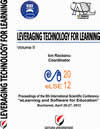INTEGRATING E-LEARNING INTO INFORMATION SYSTEMS OF ORGANIZATIONS
INTEGRATING E-LEARNING INTO INFORMATION SYSTEMS OF ORGANIZATIONS
Author(s): Mihai AndronieSubject(s): Education
Published by: Carol I National Defence University Publishing House
Keywords: Software modules; integrated information system; e-learning module; e-learning technologies
Summary/Abstract: In the modern society, computer science is being used by more and more organizations to control their activities by using special software and hardware configurations to automate the processing of data that is available. There appeared a large variety of computer applications designed for specific tasks, but still it is hard to find an application that meets all the requirements of a specific organization. Using separate computer applications for every activity that is carried on can be a solution, but in this case internal communication and compatibility issues can appear. Because creating customized software for each organization can be expensive, the best solution that emerged is to create an integrated information system composed of modules that are compatible with each other. Information systems modules cover almost all of the activities an organization is carrying on, like production control modules, inventory modules, management modules, data storage modules, human resources modules, learning modules. Among the modules that compose the information system of an organization, e-learning modules become more and more important and can be integrated in the whole system. These modules are important in modern organizations to train the employees, contributing to their lifelong learning. By using e-learning modules, an organization can have multiple advantages from the economic point of view because training the people involved in various activities can be done internally, in a way more adapted to the specific of the organization. The present paper aims to focus on the possibilities of integrating e-learning technologies in the information systems of modern organizations.
Journal: Conference proceedings of »eLearning and Software for Education« (eLSE)
- Issue Year: 8/2012
- Issue No: 02
- Page Range: 38-43
- Page Count: 6
- Language: English

